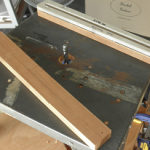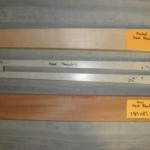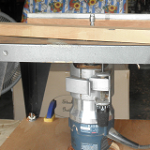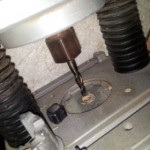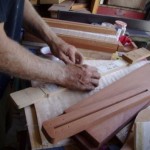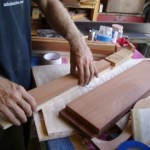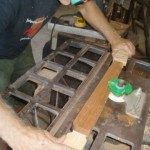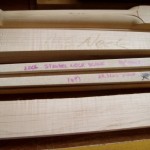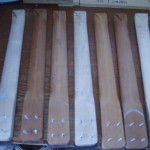Making a Strobel Rambler® Travel Guitar – Part 3
Making Necks for a Portable Guitar…
In our first two visits to the Strobel Guitars Custom Shop we saw how a Custom Rambler® Professional Electric Travel Guitar body goes from a block of wood to a shaped guitar. In Part One, we selected the wood; attached the Maple tops and glued them together with Ash, Popular or Mahogany bodies. In Part Two we saw how the Rambler® Travel Guitar bodies get sawed, shaped, routed and drilled.
Today we are taking a look at one of the more difficult parts of building a Custom Rambler® Travel Guitar; making the necks. The necks have to be precisely shaped to give them a good feel and playability. They have slanting lines in two dimensions while the back needs to be curved with a “C” or “D” (or other) profile. We tend to make our Rambler® Travel Guitar Custom necks a little on the thick side (1” at the first fret) since a thicker neck contributes to better resonance and sustain. Customers may order a thinner neck if that is their preference.
Rambler® Travel Guitar Neck Process
The travel guitar neck process starts with either a mahogany or maple board about 3” x 3” and about 3-4 feet long. A Rambler® neck blank should be about 16” long, while a Rambler® Custom Bass neck is about 18”. We try to cut the blanks so the grain of the wood is vertical to the fretboard, meaning “quarter sawn”. It is said this makes for a stronger more stable neck. For a Rambler® travel guitar, we need a neck blank about 2 ½” wide, 16” long and about 1” thick. The rectangular neck blank gets planed down to 7/8” thickness.
With the right sized neck blank, the neck template is attached with a slot in the template for routing the truss rod cavity. Using a band saw, we cut the blank into the approximate neck outline, and then use a router with a template bit (has a ball bearing that follows the template) to get the exact neck dimensions.
|
Neck Blanks on |
Neck Template |
Neck Router |
The dimensioned neck now gets a slot for the truss rod. This router has a template following collate used in combination with a ¼” end mill bit to carve the truss rod slot into the neck. The truss rod access hole is accomplished with a long ¼” drill bit, drilling from the truss rod side of the slot to the heel.
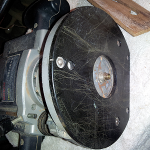 Strobel’s Router with Collate |
Strobel’s End Mill Bit |
Shaping a Rambler® Travel Guitar Neck
The necks are now the correct outline shape including a truss rod slot. They need to be shaped to the proper profile. We use a special slanted sled to shape the necks getting thinner towards the nut.
|
Attaching the |
Neck on sled |
Shaping the neck |
After getting the approximate shaped neck on the shaper, there are many hours of hand work to finesse the final shape using rasps, scrapers and of course lots of sandpaper. A variety of final shapes are available on Custom Rambler® Travel Guitars and Basses including the standard “C” and “D” shapes, “V” shapes, modified “V” etc. The customer specifies the final dimensions at the first and twelfth frets.
|
Necks in various stages |
A batch of Custom |
It takes careful planning and craftsmanship to create a great sounding, great playing, high quality travel guitar. The best thing about owning a Custom Rambler® Portable Guitar is creating the guitar of your dreams, designed just how you want it. Strobel Guitars works with you to optimize the wood selections, neck shaping and set up to match your style of playing. You pick the wood, the color, the neck shape, the inlay and choose any number of available options (piezo bridge, gold hardware, coil tap, etc.).
Next month we will show you how we make the Custom Rambler® fret boards and inlay. Customer initials are included as first fret inlay and other custom inlay options are available.

